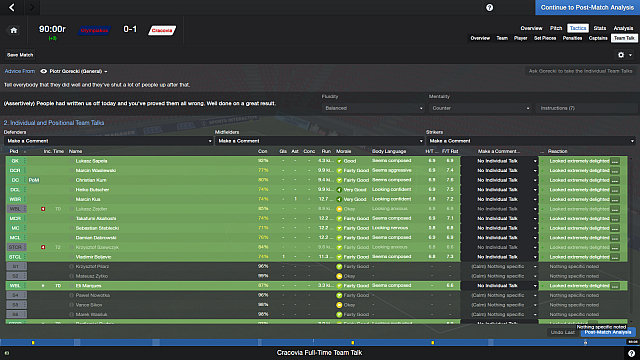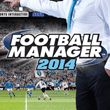Match interface | Match

Match day is a day of trial. You can finally see if all the tactical settings, hours spent on training and transfer negotiations produced the expected outcome. In Football Manager 2014, unlike FIFA or PES, you can't control the players. You do however have influence on what happens on the field - you can change players, formation, make pep talks and give instructions.
Below you can see description of specific elements of a match, settings like formation, set pieces, captains, player roles etc. were described in Tactics chapter.
Opposition instructions
In this screen you can give instructions on particular players or all positions. You can choose from:
Tight marking | Never, Always, No instruction. Attackers, offensive midfielders and the opposition's most important players should always be marked. |
Closing down | Never, Always, No instruction. The opponent will be always or never attacked by your players, they will try to force his mistake. |
Tackling | Normal, Easy, Hard, No instruction. How the players should tackle. You should set Hard to the opposition's most important players so they don't feel too comfortable. |
Show onto foot | Left foot, Right foot, Weaker foot, No instruction. It makes a selected player play with a selected foot. |
No instruction leaves everything according to a set strategy, no particular player will get more attention. You can always leave these instructions to your assistant manager.
Team talks

Team talks often get too little attention, however you should take a look at them, a good talk may turn the tide of the match. You can talk to your team before the match, during the half-time and after the match. You can talk to the whole team, specific positions or individual players.
Before a match against a weak opponent you can expect a victory, if you've been winning lately, tell your players to keep doing it. If the next game is against an experienced team, you can tell your players not to worry if you're not expecting a victory, they can surprise you and opposition's overconfidence might be to your advantage. In the half-time, depending on the score, either compliment the team or tell them that you're disappointed. The same after the match: you should compliment the players especially after a victory against an experienced team, but when they lose, you mustn't pretend that they played well (unless it was a minor failure and the opposition was very strong, then you can say it was unfair). If the players react negatively, you should talk to them individually. You can also do it by introducing a substitute.
You can see the influence on players in the Reaction column. If they react positively, their names will be underlined in green, if negatively - in red. Your talk can also be ignored, then the name won't be underlined.
Match screen

This is the match screen, view of the pitch. Specific elements marked on the screenshot.
1. Make a substitution - you can quickly introduce a new player.
2. Shout instructions - instructions that you can shout from the touchline. These are the same instructions that you can set in Player instructions tab in the tactics menu.
3. Tactic - lets you quickly change a tactic.
4. Mentality - can change team's mentality.
5. Playing style - lets you quickly change playing style.
6. Overview - here you'll see various information, for example player evaluation.
7. Settings - you can change speed, view and shown situations here.
8. Match day options - You can choose several windows to show on the screen, for example player evaluation, formation etc.
9. Maximize - Maximizes the match view.
10. Possession - shows possession and commentary.
11. Start/stop buttons - they let you stop, rewind etc.
12. Match feed - you can see all notifications, messages, your coworkers' advice etc.
13. Overview, Pitch, Tactics, Stats, Analysis - a variety of stats and tables for the match, analysis of individual players and whole team, match stats and much more.
You are not permitted to copy any image, text or info from this page. This site is not associated with and/or endorsed by the SEGA or Sports Interactive. All logos and images are copyrighted by their respective owners.
Copyright © 2000 - 2025 Webedia Polska SA for gamepressure.com, unofficial game guides, walkthroughs, secrets, game tips, maps & strategies for top games.
